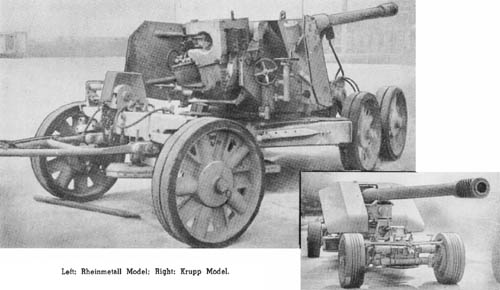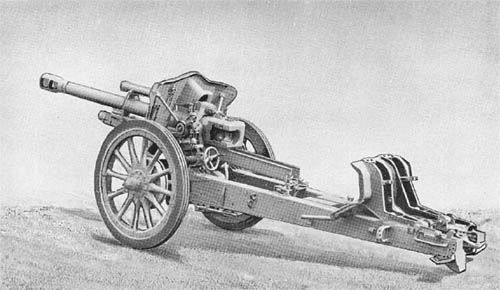
In order to obtain longer range, the 105 mm German Howitzer l.F.H. 18 was modified so that the muzzle velocity of the weapon could be increased. The Germans accomplished this by preparing a new propellant charge (Fern ladung—long range charge) which increases the muzzle velocity from approximately 1,542 feet per second to 1,772 feet per second, and the range from approximately 11,670 yards to 13,500 yards. To compensate for the increased velocity and the resulting recoil, the Germans found it necessary to add a muzzle brake. It was also necessary to slightly modify the recoil mechanism and to increase the nitrogen pressure in the counterrecoil cylinders from 730 pounds per square inch to 854 pounds per square inch. To differentiate between the two models, the letter “M” (Mündungsbremse—Muzzle Brake) was added to the old nomenclature, hence the later model is known as the l.F.H. 18 (M).
The tube is of monobloc construction. The weapon has a continuous pull firing mechanism and a breech mechanism of the horizontal sliding type. The carriage, of riveted and welded steel, is equipped with split trails, folding spades, wooden wheels with rubber tires, and a protective armor shield 4 mm thick. It also has hand operated friction brakes.
SPECIFICATIONS
| Caliber | 105 mm (4.13 ins.) | |||||||||||||||||||||||||||||||||||||||||||||||||||||||||||||||||||||||||||||||||||||||||||||||||||||||||||||||||||||||||||||||||||||||||||||||||||||||||||||||||||||||||||||||||||||||||||||||||||||||||||||||||||||||||||||||||||||||||||||||||||||||||||||||||||||||||||||||||||||||||||||||||||||||||||||||||||||||||||||||||||||||||||||||||||||||||||||||||||||||||||||||||||||||||||||||||||||||||||||||||||||||||||||||||||||||||||||||||||||||||||||||||||||||||||||||||||||||||||
| Weight (traveling position) | 4,255 lbs. | |||||||||||||||||||||||||||||||||||||||||||||||||||||||||||||||||||||||||||||||||||||||||||||||||||||||||||||||||||||||||||||||||||||||||||||||||||||||||||||||||||||||||||||||||||||||||||||||||||||||||||||||||||||||||||||||||||||||||||||||||||||||||||||||||||||||||||||||||||||||||||||||||||||||||||||||||||||||||||||||||||||||||||||||||||||||||||||||||||||||||||||||||||||||||||||||||||||||||||||||||||||||||||||||||||||||||||||||||||||||||||||||||||||||||||||||||||||||||||
| Weight (firing position) | ||||||||||||||||||||||||||||||||||||||||||||||||||||||||||||||||||||||||||||||||||||||||||||||||||||||||||||||||||||||||||||||||||||||||||||||||||||||||||||||||||||||||||||||||||||||||||||||||||||||||||||||||||||||||||||||||||||||||||||||||||||||||||||||||||||||||||||||||||||||||||||||||||||||||||||||||||||||||||||||||||||||||||||||||||||||||||||||||||||||||||||||||||||||||||||||||||||||||||||||||||||||||||||||||||||||||||||||||||||||||||||||||||||||||||||||||||||||||||||
| Length (traveling position) | 19 ft., 6 ins. | |||||||||||||||||||||||||||||||||||||||||||||||||||||||||||||||||||||||||||||||||||||||||||||||||||||||||||||||||||||||||||||||||||||||||||||||||||||||||||||||||||||||||||||||||||||||||||||||||||||||||||||||||||||||||||||||||||||||||||||||||||||||||||||||||||||||||||||||||||||||||||||||||||||||||||||||||||||||||||||||||||||||||||||||||||||||||||||||||||||||||||||||||||||||||||||||||||||||||||||||||||||||||||||||||||||||||||||||||||||||||||||||||||||||||||||||||||||||||||
| Length (firing position) | 20 ft., 5 ins. (at 0° elev.) | |||||||||||||||||||||||||||||||||||||||||||||||||||||||||||||||||||||||||||||||||||||||||||||||||||||||||||||||||||||||||||||||||||||||||||||||||||||||||||||||||||||||||||||||||||||||||||||||||||||||||||||||||||||||||||||||||||||||||||||||||||||||||||||||||||||||||||||||||||||||||||||||||||||||||||||||||||||||||||||||||||||||||||||||||||||||||||||||||||||||||||||||||||||||||||||||||||||||||||||||||||||||||||||||||||||||||||||||||||||||||||||||||||||||||||||||||||||||||||
| Height (traveling position) | 5 ft., 9 ins. | |||||||||||||||||||||||||||||||||||||||||||||||||||||||||||||||||||||||||||||||||||||||||||||||||||||||||||||||||||||||||||||||||||||||||||||||||||||||||||||||||||||||||||||||||||||||||||||||||||||||||||||||||||||||||||||||||||||||||||||||||||||||||||||||||||||||||||||||||||||||||||||||||||||||||||||||||||||||||||||||||||||||||||||||||||||||||||||||||||||||||||||||||||||||||||||||||||||||||||||||||||||||||||||||||||||||||||||||||||||||||||||||||||||||||||||||||||||||||||
| Height (firing position) | 5 ft., 9 ins. | |||||||||||||||||||||||||||||||||||||||||||||||||||||||||||||||||||||||||||||||||||||||||||||||||||||||||||||||||||||||||||||||||||||||||||||||||||||||||||||||||||||||||||||||||||||||||||||||||||||||||||||||||||||||||||||||||||||||||||||||||||||||||||||||||||||||||||||||||||||||||||||||||||||||||||||||||||||||||||||||||||||||||||||||||||||||||||||||||||||||||||||||||||||||||||||||||||||||||||||||||||||||||||||||||||||||||||||||||||||||||||||||||||||||||||||||||||||||||||
| Width (overall) | 6 ft., 6 1/2 ins. | |||||||||||||||||||||||||||||||||||||||||||||||||||||||||||||||||||||||||||||||||||||||||||||||||||||||||||||||||||||||||||||||||||||||||||||||||||||||||||||||||||||||||||||||||||||||||||||||||||||||||||||||||||||||||||||||||||||||||||||||||||||||||||||||||||||||||||||||||||||||||||||||||||||||||||||||||||||||||||||||||||||||||||||||||||||||||||||||||||||||||||||||||||||||||||||||||||||||||||||||||||||||||||||||||||||||||||||||||||||||||||||||||||||||||||||||||||||||||||
| Width of trail spread | 15 ft., 10 ins. | |||||||||||||||||||||||||||||||||||||||||||||||||||||||||||||||||||||||||||||||||||||||||||||||||||||||||||||||||||||||||||||||||||||||||||||||||||||||||||||||||||||||||||||||||||||||||||||||||||||||||||||||||||||||||||||||||||||||||||||||||||||||||||||||||||||||||||||||||||||||||||||||||||||||||||||||||||||||||||||||||||||||||||||||||||||||||||||||||||||||||||||||||||||||||||||||||||||||||||||||||||||||||||||||||||||||||||||||||||||||||||||||||||||||||||||||||||||||||||
| Length of bore | 25.7 cals. | |||||||||||||||||||||||||||||||||||||||||||||||||||||||||||||||||||||||||||||||||||||||||||||||||||||||||||||||||||||||||||||||||||||||||||||||||||||||||||||||||||||||||||||||||||||||||||||||||||||||||||||||||||||||||||||||||||||||||||||||||||||||||||||||||||||||||||||||||||||||||||||||||||||||||||||||||||||||||||||||||||||||||||||||||||||||||||||||||||||||||||||||||||||||||||||||||||||||||||||||||||||||||||||||||||||||||||||||||||||||||||||||||||||||||||||||||||||||||||
| No. of grooves | 32—R.H. Progressive Twist | |||||||||||||||||||||||||||||||||||||||||||||||||||||||||||||||||||||||||||||||||||||||||||||||||||||||||||||||||||||||||||||||||||||||||||||||||||||||||||||||||||||||||||||||||||||||||||||||||||||||||||||||||||||||||||||||||||||||||||||||||||||||||||||||||||||||||||||||||||||||||||||||||||||||||||||||||||||||||||||||||||||||||||||||||||||||||||||||||||||||||||||||||||||||||||||||||||||||||||||||||||||||||||||||||||||||||||||||||||||||||||||||||||||||||||||||||||||||||||
| Width of grooves | ||||||||||||||||||||||||||||||||||||||||||||||||||||||||||||||||||||||||||||||||||||||||||||||||||||||||||||||||||||||||||||||||||||||||||||||||||||||||||||||||||||||||||||||||||||||||||||||||||||||||||||||||||||||||||||||||||||||||||||||||||||||||||||||||||||||||||||||||||||||||||||||||||||||||||||||||||||||||||||||||||||||||||||||||||||||||||||||||||||||||||||||||||||||||||||||||||||||||||||||||||||||||||||||||||||||||||||||||||||||||||||||||||||||||||||||||||||||||||||
| Depth of grooves | ||||||||||||||||||||||||||||||||||||||||||||||||||||||||||||||||||||||||||||||||||||||||||||||||||||||||||||||||||||||||||||||||||||||||||||||||||||||||||||||||||||||||||||||||||||||||||||||||||||||||||||||||||||||||||||||||||||||||||||||||||||||||||||||||||||||||||||||||||||||||||||||||||||||||||||||||||||||||||||||||||||||||||||||||||||||||||||||||||||||||||||||||||||||||||||||||||||||||||||||||||||||||||||||||||||||||||||||||||||||||||||||||||||||||||||||||||||||||||||
| Width of lands | ||||||||||||||||||||||||||||||||||||||||||||||||||||||||||||||||||||||||||||||||||||||||||||||||||||||||||||||||||||||||||||||||||||||||||||||||||||||||||||||||||||||||||||||||||||||||||||||||||||||||||||||||||||||||||||||||||||||||||||||||||||||||||||||||||||||||||||||||||||||||||||||||||||||||||||||||||||||||||||||||||||||||||||||||||||||||||||||||||||||||||||||||||||||||||||||||||||||||||||||||||||||||||||||||||||||||||||||||||||||||||||||||||||||||||||||||||||||||||||
| Muzzle velocity (maximum) | 1,772 f/s* | |||||||||||||||||||||||||||||||||||||||||||||||||||||||||||||||||||||||||||||||||||||||||||||||||||||||||||||||||||||||||||||||||||||||||||||||||||||||||||||||||||||||||||||||||||||||||||||||||||||||||||||||||||||||||||||||||||||||||||||||||||||||||||||||||||||||||||||||||||||||||||||||||||||||||||||||||||||||||||||||||||||||||||||||||||||||||||||||||||||||||||||||||||||||||||||||||||||||||||||||||||||||||||||||||||||||||||||||||||||||||||||||||||||||||||||||||||||||||||
| Max. range (horizontal) (Reported) | 13,500 yds. | |||||||||||||||||||||||||||||||||||||||||||||||||||||||||||||||||||||||||||||||||||||||||||||||||||||||||||||||||||||||||||||||||||||||||||||||||||||||||||||||||||||||||||||||||||||||||||||||||||||||||||||||||||||||||||||||||||||||||||||||||||||||||||||||||||||||||||||||||||||||||||||||||||||||||||||||||||||||||||||||||||||||||||||||||||||||||||||||||||||||||||||||||||||||||||||||||||||||||||||||||||||||||||||||||||||||||||||||||||||||||||||||||||||||||||||||||||||||||||
| Traverse | 56° | |||||||||||||||||||||||||||||||||||||||||||||||||||||||||||||||||||||||||||||||||||||||||||||||||||||||||||||||||||||||||||||||||||||||||||||||||||||||||||||||||||||||||||||||||||||||||||||||||||||||||||||||||||||||||||||||||||||||||||||||||||||||||||||||||||||||||||||||||||||||||||||||||||||||||||||||||||||||||||||||||||||||||||||||||||||||||||||||||||||||||||||||||||||||||||||||||||||||||||||||||||||||||||||||||||||||||||||||||||||||||||||||||||||||||||||||||||||||||||
| Elevation | 40° | |||||||||||||||||||||||||||||||||||||||||||||||||||||||||||||||||||||||||||||||||||||||||||||||||||||||||||||||||||||||||||||||||||||||||||||||||||||||||||||||||||||||||||||||||||||||||||||||||||||||||||||||||||||||||||||||||||||||||||||||||||||||||||||||||||||||||||||||||||||||||||||||||||||||||||||||||||||||||||||||||||||||||||||||||||||||||||||||||||||||||||||||||||||||||||||||||||||||||||||||||||||||||||||||||||||||||||||||||||||||||||||||||||||||||||||||||||||||||||
| Depression | 7° | |||||||||||||||||||||||||||||||||||||||||||||||||||||||||||||||||||||||||||||||||||||||||||||||||||||||||||||||||||||||||||||||||||||||||||||||||||||||||||||||||||||||||||||||||||||||||||||||||||||||||||||||||||||||||||||||||||||||||||||||||||||||||||||||||||||||||||||||||||||||||||||||||||||||||||||||||||||||||||||||||||||||||||||||||||||||||||||||||||||||||||||||||||||||||||||||||||||||||||||||||||||||||||||||||||||||||||||||||||||||||||||||||||||||||||||||||||||||||||
| Length of recoil | 39.3 ins.—46.8 ins. | |||||||||||||||||||||||||||||||||||||||||||||||||||||||||||||||||||||||||||||||||||||||||||||||||||||||||||||||||||||||||||||||||||||||||||||||||||||||||||||||||||||||||||||||||||||||||||||||||||||||||||||||||||||||||||||||||||||||||||||||||||||||||||||||||||||||||||||||||||||||||||||||||||||||||||||||||||||||||||||||||||||||||||||||||||||||||||||||||||||||||||||||||||||||||||||||||||||||||||||||||||||||||||||||||||||||||||||||||||||||||||||||||||||||||||||||||||||||||||
| Ammunition | H.E. w/P.D. Fuze: Hollow Charge; Smoke; A.P.; Incendiary | |||||||||||||||||||||||||||||||||||||||||||||||||||||||||||||||||||||||||||||||||||||||||||||||||||||||||||||||||||||||||||||||||||||||||||||||||||||||||||||||||||||||||||||||||||||||||||||||||||||||||||||||||||||||||||||||||||||||||||||||||||||||||||||||||||||||||||||||||||||||||||||||||||||||||||||||||||||||||||||||||||||||||||||||||||||||||||||||||||||||||||||||||||||||||||||||||||||||||||||||||||||||||||||||||||||||||||||||||||||||||||||||||||||||||||||||||||||||||||
| Wt. of projectile | 32 3/4 lb. (Long Range H.E. Shell) | |||||||||||||||||||||||||||||||||||||||||||||||||||||||||||||||||||||||||||||||||||||||||||||||||||||||||||||||||||||||||||||||||||||||||||||||||||||||||||||||||||||||||||||||||||||||||||||||||||||||||||||||||||||||||||||||||||||||||||||||||||||||||||||||||||||||||||||||||||||||||||||||||||||||||||||||||||||||||||||||||||||||||||||||||||||||||||||||||||||||||||||||||||||||||||||||||||||||||||||||||||||||||||||||||||||||||||||||||||||||||||||||||||||||||||||||||||||||||||
| Rheinmetall | Krupp | |||
| Length of gun (including muzzle brake and breech ring) | 312 1/2 ins. | 299 ins. | ||
| Length of gun (including breech ring) | 277 1/2 ins. | 277 1/8 ins. | ||
| Length of chamber (from rifling) | 41 3/4 ins. | 41 3/4 ins. | ||
| Length of rifling | 219 1/2 ins. | 219 1/2 ins. | ||
| Overall length (traveling position) | not determined | 433 ins. | ||
| Overall width (traveling position) | 108 1/4 ins. | 98 ins. | ||
| Overall height (traveling position) | 81 ins. | 90 ins. |
German: p. 106.2 (August 1, 1945)
12.8 cm Flak 40: Heavy Antiaircraft Gun
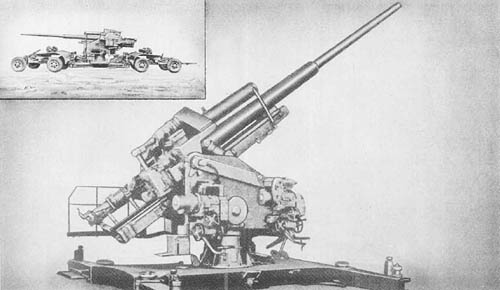
This weapon, together with the 8.8 cm Flak 41, is Germany’s standard heavy antiaircraft gun. There are four different type mounts used with the gun: mobile, static, railway, and a twin mounting. When used with the latter, the equipment is known as the 12.8 cm Flakzwilling.
In construction and appearance this weapon resembles the 10.5 cm antiaircraft gun described on page 109. The barrel consists of a three-piece tube with jacket and sleeve. The breech mechanism is of the horizontal sliding block type, and an electric firing device is used. A hydropneumatic recuperator is located above the barrel, and a hydraulic buffer below.
Elevating and traversing may be operated either by power or by handwheels; are located on the right side of the equipment with the layers seated facing the gun. A machine fuze setting gear and loading and ramming gear identical with those of the 10.5 cm Flak are used.
The static mounting is a pedestal type secured to a concrete base. The cradle pivots in trunnions mounted at the extreme rear of the upper carriage, and almost in line with the breechblock. A large box-like construction, located underneath the buffer and forward of the elevating arc, contains the oil motors. The equilibrators extend from an anchoring just forward of the trunnions to the forward edge of the casing containing the oil motors.
The gun being extremely high off the ground, platforms for the gun crew are provided. The gun is fitted to receive firing data by remote control transmission. A normal panoramic sight is provided as well as an antitank sight.
SPECIFICATIONS
| Caliber | 12.8 cm (5.04 ins.) | |
| Weight (static mount) | 28,600 lbs. | |
| Weight (traveling position) | 59,400 lbs. | |
| Mobile mount | ||
| Weight (firing position) | 37,400 lbs. | |
| Mobile mount | ||
| Length (traveling position) | 49 ft. | |
| overall | ||
| Length (firing position) | 29 ft. | |
| overall | ||
| Height (traveling position) | ||
| Height (firing position) | ||
| Height of trunnions (firing position) | 7 5/8 ft. | |
| Width (overall) | ||
| Length of piece | 308.5 ins. (61 calibers) | |
| Length of rifling | 255.13 ins. | |
| Twist of rifling (increasing) | 3° 20′ to 5° 30′ | |
| No. of grooves | 40 | |
| Width of grooves (forward section) | 0.26 in. | |
| (center section) | 0.25 in. | |
| Depth of grooves | 0.06 in. | |
| Width of lands (forward section) | 0.13 in. | |
| (center section) | 0.14 in. | |
| Muzzle velocity (H.E. shell) | 2,886 f/s | |
| Max. range (horizontal) | 20,950 meters (22,910 yds.) | |
| Max. ceiling at 85° | 14,800 meters (48,555 ft.) | |
| Rate of fire | 12 r.p.m. | |
| Traverse | 360° | |
| Elevation | 88° | |
| Depression | -3° | |
| Length of recoil | from 36 to 51 ins. | |
| Ammunition | A.P.C., H.E. | |
| Wt. of complete round (approx.) | 106 lbs. | |
| Wt. of H.E. projectile (12.8 cm Sprgr. Patr. I. 4.5) | 57 lbs. | |
| Wt. of A.P.H.E. projectile (12.8 cm Pzgr. Patr.) | 58.13 lbs. |
German: p. 106.1 (August 1, 1945)
15 cm K. 39: Medium Field Gun
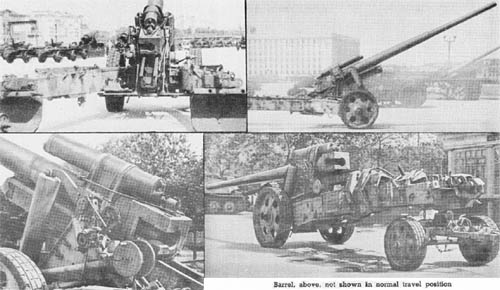
The K. 39 was gradually replacing the K. 18 as Germany’s standard medium mobile artillery weapon. It is basically the same design as the earlier model, and has an identical range, muzzle velocity, and chamber pressure. Modifications to the piece, while extensive, were confined largely to the carriage, which resembles the
The tube is approximately two inches longer than that of the K. 18, and the rifling was changed from a 6° constant twist to a variable one, increasing from 4° 17′ to 5° 59′. The breech mechanism is of the horizontal sliding block type. The hydraulic recoil cylinder is apparently the same as that on the K. 18, but the hydropneumatic counterrecoil cylinder is shorter and larger in diameter than that of the earlier model. Length of recoil varies from 1250 mm to 1500 mm (49.2 inches to 59.2 inches). The equilibrators of both the K. 18 and the K. 39 are of the push type, but those on the K. 39 are spring activated. Elevation and traverse are accomplished in much the same manner, changes being principally in the location of the handwheels. A rigid gunners’ platform constructed of a non-skid open steel lattice work is bolted to the upper carriage. Although awkward in appearance, it performs the function for which it was intended without hampering the movements of the crew about the gun.
Traverse has been increased from 12° to 60° by the use of a split trail with detachable spades instead of the box-type trail used on the K. 18.
SPECIFICATIONS
| Caliber | 149 mm | |
| Weight (traveling position) | ||
| Weight (firing position) | 27,300 lbs. | |
| Length (traveling position) | ||
| Length (firing position) | ||
| Height (traveling position) | ||
| Height (firing position) | ||
| Width (overall) | ||
| Width of trail spread | ||
| Twist of rifling—increasing | 4° 17′ to 5° | |
| Length of barrel | 325 ins. | |
| Length of rifling | 256.6 ins. | |
| Volume of chamber | 1,829 cu. ins. | |
| M uzzle velocity | 2,840 f/s | |
| Max. range (horizontal) | 24.7 km | |
| Rate of fire | ||
| Traverse | 60° | |
| Elevation | 45° | |
| Depression | 4° | |
| Length of recoil (max.) | 1,500 mm | |
| Ammunition types | H.E.; anticoncrete, APHE | |
| Weight of max. charge | 41.2 lbs. | |
| Weight of projectile (HE) | 94.6 lbs. |
15 cm K. 18: Medium Field Gun
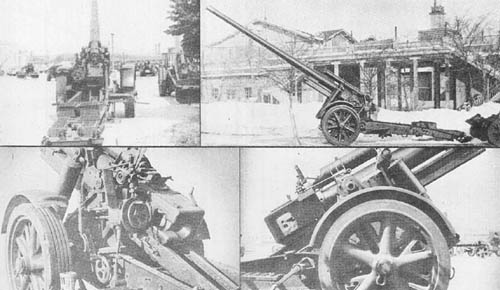
This weapon was being replaced by the 15 cm K. 39 during the closing months of the European war. For transport, the K. 18 may be broken down into two loads and drawn by either horse or truck.
The built-up tube consists of a main tube, breech jacket, and breech ring. Rifling is a 6° constant twist. Hydraulic recoil and hydropneumatic counterrecoil cylinders are of standard German design. The buffer is located below, and the recuperator above the piece.
A rectangular breech ring has a crank-operated horizontal sliding type breechblock opening to the right. Two pneumatic, push-type equilibrators are incorporated in the design.
Elevation and depression are accomplished by means of an off-center elevating arc which is operated by a handwheel on the left side of the piece. The traversing handwheel is also located on the left.
The carriage is mounted on two rubber-tired wheels and has a hollow, box-type trail allowing a total traverse of 12 degrees.
The ammunition is semi-fixed; there are three charges.
SPECIFICATIONS
| Caliber | 149 mm | |
| Weight (firing position) | 28,400 lbs. | |
| Maximum chamber pressure | 41,200 lbs./sq. in. | |
| Length of barrel | 323 ins. | |
| Twist of rifling, constant | 6° | |
| Length of rifling | 253 ins. | |
| Volume of chamber | 1,770 cu. ins. | |
| Muzzle velocity | 2,840 f/s | |
| Max. range (horiontal) | 27,000 yds. | |
| Traverse | 12° | |
| Elevation | 43° | |
| Depression | 2° | |
| Length of recoil | 1,450 mm | |
| Ammunition types | HE; anticoncrete | |
| Weight of max. charge | 42.5 lbs. | |
| Weight of projectile (HE) | 94.6 lbs. |
German: p. 104.3 (June 1, 1945)
15 cm K. 16: Heavy Field Gun
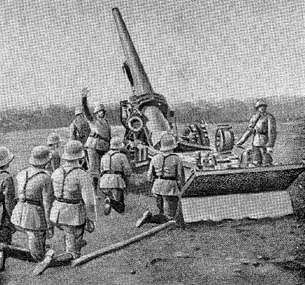
The 15 cm K. 16 differs from other German 15 cm guns by reason of its appreciably heavier projectile. The ammunition employed in the K. 16 is not interchangeable with other guns of the caliber.
This weapon is generally regarded as obsolete, although it may be employed as a coast defense weapon or in some other static role. The piece may be used on the
Features of the 15 cm K. 16 are: the location of the buffer and recuperator below the piece; a large three-ribbed collar which surrounds the piece just forward of the breech ring; a cylindrical breech ring; and a box-type trail terminating in a spade of massive dimensions.
SPECIFICATIONS
| Caliber | 150 mm (5.9 ins.) | |
| Weight in action | 24,000 lbs. | |
| Length of piece | 248 ins. | |
| Elevation | 42° | |
| Depression | -3° | |
| Traverse | 8° | |
| Maximum range | 21,370 yds.* | |
| Maximum muzzle velocity | 2,480 f/s* | |
| Ammunition | H.E. Capped | |
| Weight of projectile | 113 lb. | |
| Propellant | ||
| 16 lb. Ngl R.P. plus 3 oz. igniter powder | ||
| 26 lb. Ngl R.P. plus 3 oz. igniter powder | ||
| 29 lb. Ngl R.P. plus 3 oz. igniter powder | ||
*Not verified.
German: p. 104.1
21 cm K. 39: Heavy Field Gun
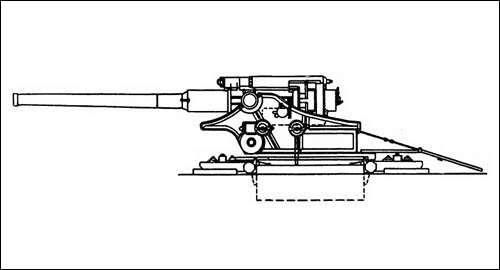
The 21 cm heavy field gun (K. 39), an original Skoda design, was taken over by the German Army shortly after the invasion of Czechoslovakia. For transport, the equipment may be broken down into three loads, each of which is mounted on two 2-wheeled, pneumatic-tired bogies.
The piece consists of an autofrettaged monobloc barrel and loose liner, and a breech ring. The breechblock is of the interrupted screw threaded type, incorporating an obturator pad, obturator spindle and percussion firing lock. On recoil, the piece slides in a cylindrical sleeve in the cradle.
The upper carriage is fitted to a turntable which revolves on a ball race mounted in the platform. The platform consists of a rectangular sheet steel box which is dug into the ground. Four removable arms located at the corners of the platform support it by bearing on the ground by means of special feet. During transport, the arms are lowered and serve to support the platform on its bogies.
The traversing and elevating mechanisms, each with two-speed gearing, are operated from handwheels on the left of the carriage.
Four types of ammunition are used in the gun: the original Czech high explosive shell; a German version of the same shell with the base fuze omitted; an anti-concrete shell with ballistic cap and base fuze; and an armor-piercing shell with base fuze. It is loaded at 8° elevation with the help of a special 2-wheeled shell trolley.
There are two other versions of the weapon, the K. 39/40 and the 39/41. Although the two later models are modifications of the original Skoda design, they do not differ in main performance details
SPECIFICATIONS
| Caliber | 210 mm (8.27 ins.) | |
| Weight (traveling position) | Three loads approx. 16 1/2 tons each | |
| Weight (firing position) | 37.2 tons | |
| Length of barrel including breech ring | 31.3 ft. | |
| Muzzle velocity (max.) | 2,625 f/s | |
| Max. range (horizontal) | 32,800 yds. | |
| Traverse | 360° | |
| Wt. of max. charge | 82.8 lbs. | |
| Elevation | 45° | |
| Depression | -4° | |
| Ammunition | H.E.; Anti-concrete; A.P. | |
| Wt. of projectile | All 298 lbs. |
German: p. 100.3 (May 1, 1945)
28 cm K5 (E): Railway Gun
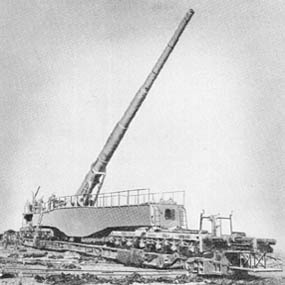
The German 28 cm K5 (E) has an unconfirmed range of 31 miles and fires a pre-engraved projectile weighing approximately 550 pounds. It is fired from a turntable affording a 360° traverse.
The gun has a 70-foot 8-inch barrel held in a sleeve-type cradle. The barrel recoil mechanism, fitted between two arms projecting downward from the cradle, consists of two hydropneumatic cylinders and a single hydraulic buffer cylinder. The cradle is supported by trunnions which rest in bearings on top of a box-like frame, of girder construction, which in turn is supported on two pintles resting in bearings in the center of two 12-wheel trucks. The front pintle bearing rides in a rail on the front truck and can be positioned six inches either side of center, thereby allowing a car traverse of approximately 1°.
The equipment in effect has a double recoil action. Besides the barrel recoil which is approximately 32 inches, the gun car recoils. It is coupled to the front of the turntable platform by a hydraulic buffer and a hydropneumatic counterrecoil mechanism which returns the car to battery position.
A turntable platform is transported as part of the equipment and in transport forms a flat car with a 103-foot bed resting on two 8-wheel trucks.
A central jack helps support the tremendous weight of the gun and carriage which amounts to around 230 tons and also serves as a central pivot for the turntable.
The powder chamber is approximately 10 feet 5 inches long. Obturation is obtained by means of a short brass cartridge case and the breech is closed with a horizontal sliding type of breechblock. Firing is of the percussion type.
SPECIFICATIONS
| Caliber | 280 mm (11 ins.) | |
| Length of barrel | 70 ft., 8 ins. | |
| Length of tube | 67 ft., 5 ins. | |
| Length of rifling | 57 ft. | |
| Rifling | Right Hand uniform twist | |
| Weight of barrel (Leopold)* | 187,880 lb. | |
| Length of car | 95 ft., 7 ins. | |
| Length of carriage | 69 ft., 8 ins. | |
| Width of carriage (overall) | 8 ft., 8 1/2 ins. | |
| Number of grooves | 12 | |
| Width of grooves | 5/8 in. | |
| Depth of grooves | 17/64 in. | |
| Max. range | 54,680 yds.** | |
| Traverse on turntable | 360° | |
| Carriage traverse (approx.) | 1/2° R; 1/2° | |
| Elevation (estimated) | 50° | |
| Ammunition | Separate loading—steel splined projectile | |
| Weight of projectile (approx.) | 550 lb. |
*Two of these guns were found in Italy; one was called “Leopold,” and the other “Robert.” The weight of the barrel on the latter model is 187,165 pounds.
**Not verified.
German: p. 100.2
Portable Gantry Crane
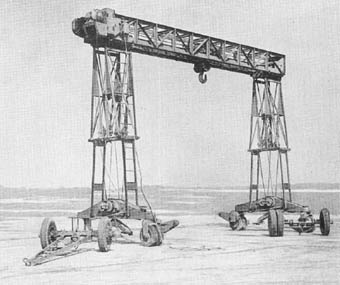
The portable Gantry Crane was manufactured in 1942 by J.S. Fries & Son, Frankfurt, Germany. It has a capacity of 33,000 pounds, and is used by field tank maintenance units in removing turrets and engines from heavy German tanks.
With a crew of eight men, the crane can be erected from traveling position to the operating position in an estimated time of twenty minutes. When the crane is in the operating position, it can be moved on its bogies on hard surface ground, or it can be run on rails that engage the flanges on the inside of the bogie wheels.
The equipment has a tendency to be top heavy in the traveling position. It is easily erected to the operating position because of its jack-knife tubular legs which are equipped with wire cable tackle blocks and manual winch.
The bridge is fabricated from welded “I” beams and angle iron shapes. The hoisting winch and motor assembly are permanently mounted at one end of the bridge. The motor, a ten-horsepower, three-phase, fifty-cycle 220/380-volt squirrel cage induction type, is equipped with magnetic friction brake and a two-station start-and-stop starter.
The hoisting block, a twin sheave type using a six-37-strand three-quarter-inch galvanized cable, can be raised or lowered manually when power is off.
The trolley is supported by four ball bearing flanged wheels and has ball bearing equipped sheaves. The trolley is traversed manually by a chain.
SPECIFICATIONS
| Weight | 17,250 lb. | |
| Weight on front wheels | 9,170 lb. | |
| Weight on rear wheels | 8,180 lb. | |
| Length (overall) | 48 ft. | |
| Length of bridge | 30 ft., 5 ins. | |
| Length of bridge track | 23 ft., 9 ins. | |
| Length of drawbar | 11 ft. | |
| Width (overall) | 7 ft., 4 1/2 ins. | |
| Width of bridge | 3 ft., 3 ins. | |
| Height (overall) | 22 ft., 8 ins. | |
| Height in traveling position | 8 ft., 2 ins. | |
| Height of bridge | 2 ft., 7 1/2 ins. | |
| Center to center of bridge track | 2 ft., 3 ins. | |
| Tread centers (front) | 5 ft. | |
| Tread centers (rear) | 6 ft., 8 ins. | |
| Ground clearance at axles | 1 ft. | |
| Ground clearance at bogie wheels | 5 1/2 ins. | |
| Tire size | 34 x 7 (8.00 x 20) | |
| Bogie wheel size | 150 x 410 mm – 5.9 in. x 16.1 in. | |
| Capacity | 15 tons |
German: p. 62.1
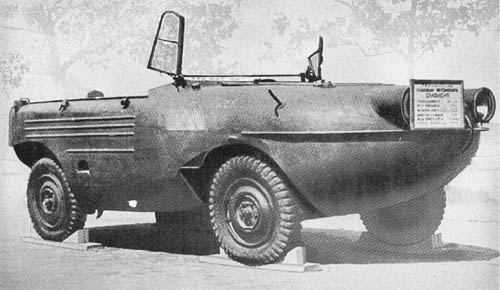
Development of this vehicle began prior to 1939 at the Trippelwerke Hamburg Saar. According to German press reports, in 1941 Mr. Hans Trippel, the inventor, made improvements over his earlier models as a result of experiments and his plant prepared to go into mass production. The above vehicle was manufactured in 1942. Field examination shows that the application of its design to combined land and water transportation is successful. Simplicity of design throughout makes it possible to produce the vehicle in large quantities very easily.
The body is arranged with a front engine compartment, a center crew compartment, and a rear stowage compartment. Water sealing is accomplished by means of rubber seals throughout. The only openings in the rear of the body are for the wheel and propeller drive and for the shafts of the shock absorbers. In the front of the body there are three openings on each side as follows: one for the shock absorber rod, the radius rod, and for the wheel drive.
Four-wheel drive with independent double coil spring suspension contributes to the cross-country mobility which is said to be remarkable. The shock absorbers are mounted inside the hull and connect with the suspension through an auxiliary shaft that is stuffing box sealed.
A special transmission is provided with three speeds forward and one reverse for highways plus three speeds forward and one reverse for cross-country and a forward and reverse gear for operation in the water. The three-bladed propeller is lowered to position when in the water and is protected inside the body work when on land. Steering is accomplished by front wheels. A one-shot lubrication system is operated from the dash.
SPECIFICATIONS
| Weight (net) | 3,860 lb. | |
| Cargo capacity (land) | 2,400 lb. | |
| Cargo capacity (water) | 2,100 lb. | |
| Length (overall) | 190 ins. | |
| Width (overall) | 71 ins. | |
| Height (overall—top of windshield) | 74 ins. | |
| Ground clearance | 15 ins. | |
| Tread center to center | 58 1/2 ins. | |
| Tire (Continental, cross-country type) | 6.00 x 18 ins. | |
| Wheel base | 98 ins. | |
| Freeboard | 12 ins. | |
| Speed (highway) | 44 m.p.h. | |
| Speed (water) | 6-10 m.p.h. | |
| Radius of action (land) | 130 miles | |
| Radius of action (water) | 46 miles | |
| Fuel tank | 15 1/2 gal. | |
| Fuel consumption (land) | 9.7 m.p.g. | |
| Fuel consumption (water) | 4.35 m.p.g. | |
| Engine | Double radiator, water-cooled, details unknown. | |
| Brakes | 4-wheel hydraulic | |
| Crew | 5 | |
| Ignition and Electrical System | 12-volt Bosch |
German: p. 58.2
